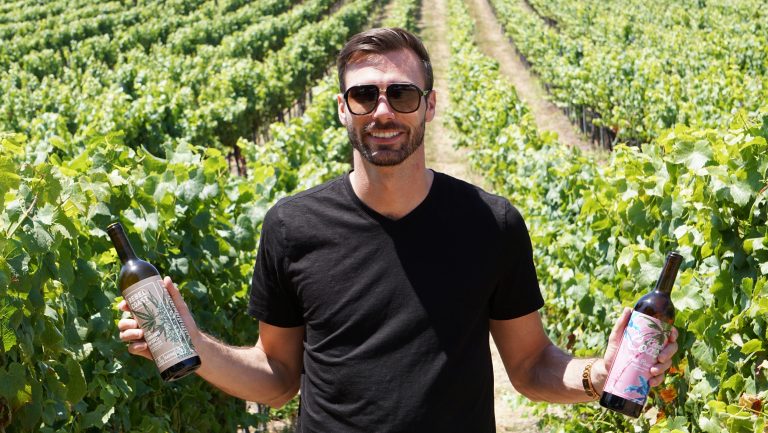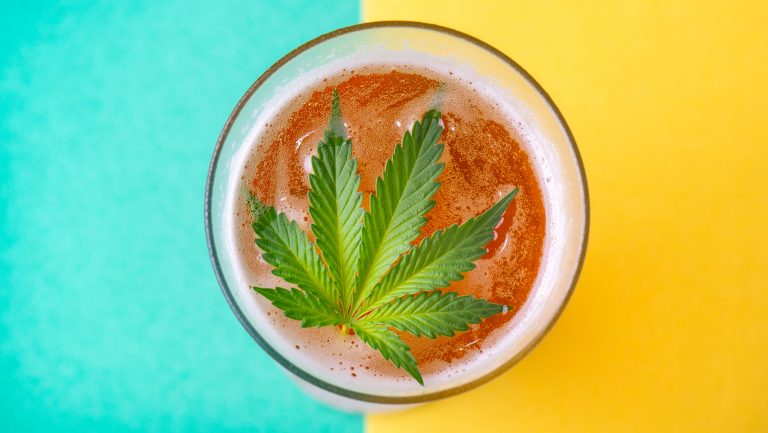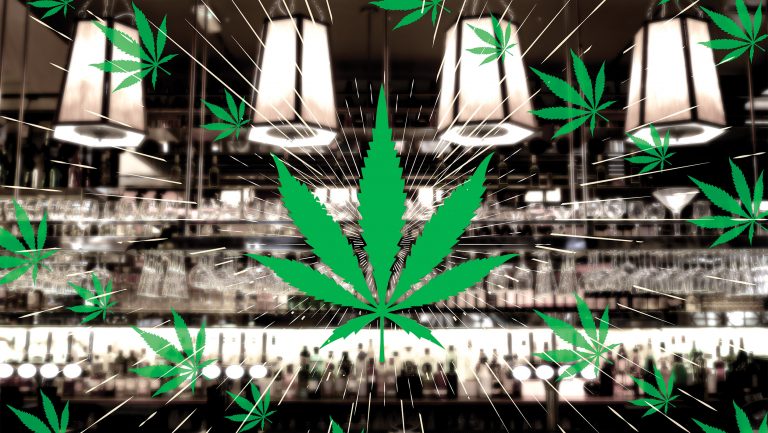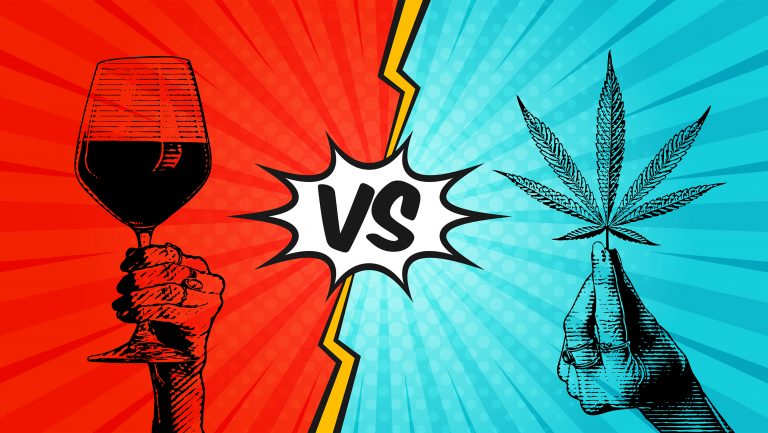During the days of Prohibition, federal law decreed the production of alcohol to be illegal, but it was not illegal to consume it, so one of the ways drinkers could get their fix was by obtaining a prescription for medicinal use. Today, another medicinal substance—cannabis—stands on complicated legal ground, caught in the contradictory crosshairs of federal and state regulations, while on the brink of contributing to whole new categories of consumable products, including cannabis-infused wine.
In the race to capitalize on all the ways cannabis can be consumed, only a handful of companies have set their sights on cannabis-infused wine, and only a few, it seems, have been successful in actually bringing a product to market.
What is cannabis-infused wine, exactly? Of the few examples in the marketplace, each begins as an alcohol-based wine before being dealcoholized and blended with a CBD- or THC-infused emulsion.

Don’t miss the latest drinks industry news and insights. Sign up for our award-winning newsletters and get insider intel, resources, and trends delivered to your inbox every week.
Aaron Silverstein, the managing director of BevZero, a company based in Santa Rosa, California that’s focused on producing dealcoholized wine, beer, and other beverages, is at the forefront of assisting cannabis companies. Silverstein says that while the process of removing alcohol from wine has traditionally stripped away aromas and flavors, his company’s process “captures” the esters, thiols, terpenes, and pyrazines in a liquid that he calls “the pure essence of the original wine,” so that the new, nonalcoholic beverage “smells great and tastes as good as the original wine.” At that point, it’s primed for blending with the cannabis emulsion.
Many of the first cannabis wines produced in the past couple of years focused on infusions rather than blended emulsions. The two differ in that infusion requires cannabis plants to be submerged directly in wine—like making tea-—while emulsions are oil-based, water-soluble solutions that are more smoothly incorporated into other liquids, like wine. Infusions extract all kinds of terpenes, good and bad, and some of the first wines made this way exhibited pungent, off-putting, skunky pine flavors and aromas. New technologies have made it possible to strip away those unwanted flavors to produce aromaless and colorless THC- and CBD-rich emulsions.
One such cannabis emulsion is created in a laboratory by companies such as Vertosa (previously branded as Nanogen Labs), based in Oakland. Nanogen uses “nanoemulsion technology” to create tiny droplets of CBD- or THC-rich fluid that are stabilized so the emulsion doesn’t separate.
Such nanoemulsions are revolutionizing the food and beverage industry. They are “created by using energy to break up oil droplets into billions of smaller droplets and then using specially formulated solutions to encapsulate them while suspending them in water,” says Nanogen’s CEO, Ben Larson, “essentially redefining the relationship between oil and water.
“The small droplet size of a nanoemulsion formula provides greater advantages and wider benefits when compared with conventional colloidal systems [emulsions with larger particles that have a greater potential to separate],” Larson continues. These benefits include “long-term stability, high water compatibility, high optical clarity, and increased bioavailability.” In the last case, cannabis-infused wines derived from nanoemulsion blends are more efficiently absorbed and processed by the body than edible forms of cannabis.

Jamie Evans, the founder of The Herb Somm, based in San Francisco, and a SevenFifty Daily 2018 Innovator, has followed the cannabis space for the last few years and is excited about the advances in technology. She points to companies like House of Saka, based in Napa, California, and Rebel Coast Winery in Sonoma as the leading pioneers of cannabis-infused wines. “House of Saka is really onto new technology,” she says, “and the [cannabis] formulation really matters because if producers get it wrong, the wine becomes unstable” and—poof—you have a lava lamp sitting on the shelf.
Understanding the Intoxicating Effects of Cannabis Wine
Evans, whose lifestyle book on CBD will be published in Spring 2020 by Fair Winds Press, says, “Cannabis is a botanical medicine, and it really does affect people in different ways. It’s critical for brands to know exactly who their consumer is so they can tailor the dosage levels for the right audience.”
Evans believes that micro-dosage drinks are likely the future of cannabis-based beverages. “If you’re having a drink with maybe 1 mg of THC,” she says, “that is a low dose and super approachable for beginners.” She admits, though, that a low dose isn’t for everyone. “I’ve met users who needed 30 mg of THC to feel the effects,” she says. “It all depends on [each person’s] endocannabinoid system—the cannabinoid receptors in the body. [For instance,] I don’t need as much THC as my husband, who requires a higher dose, so it depends on your body and your metabolism.”
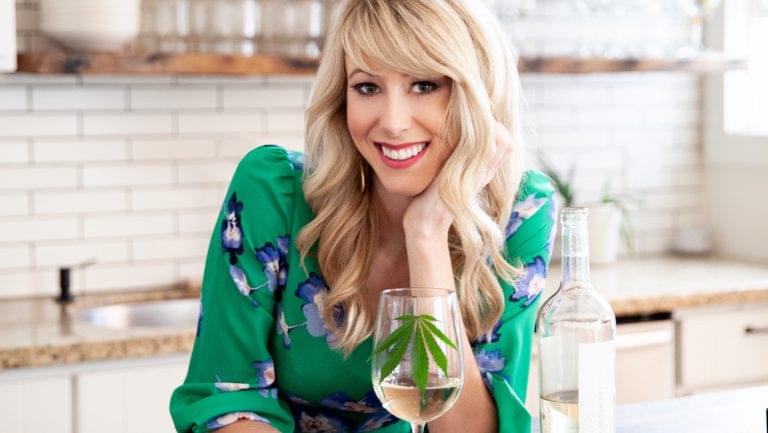
Ingested THC is absorbed into the body through the liver. But the way individuals are affected depends on their “bioavailability rates,” explains Evans—in other words, the way the body responds to THC as it’s metabolized, which is different from the response to smoking it. Someone with a high tolerance for smoking cannabis may have a low tolerance for ingesting it. Evans’s advice for every user is to “start low and go slow.” Another factor to consider is onset times. “Smoking has immediate impacts,” Evans says. “Sublinguals [tinctures] take effect after 15 to 20 minutes. Edibles take one or two hours, and drinkables about 45 minutes to one hour [to metabolize].”
House of Saka produces Saka Pink, a nonalcoholic THC- and CBD-infused rosé that will be available in a still and sparkling version (Saka Sparkling Pink) and is poised to retail for $40 and $70, respectively. Saka Pink offers delicate red-fruit aromas like strawberry and raspberry, with elderflower and rose-petal notes. It has good weight, is juicy, and there’s no weedy taste, as you might expect. The sparkling version tastes similar, if not a little drier, and is quite refreshing.
Tracey Mason, House of Saka’s CEO, says that one bottle of Saka Pink contains 20 mg of THC and 5 mg of CBD, which equates to roughly 5 mg total in each glass—the equivalent serving size of most small cannabis edibles, particularly chocolates. Mason says the company’s cannabis-infused beverage gives a “body high and head high and is highly bioavailable,” and will retain its full potency for one year in the bottle but should be consumed within two or three days after opening, as is the case with wines because of oxidation.
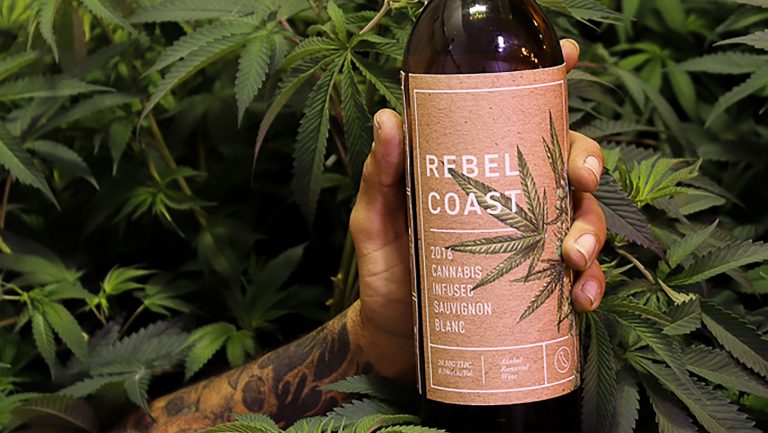
Another producer, Rebel Coast, made its first commercial batch of a cannabis-infused nonalcoholic Sauvignon Blanc from Napa Valley in early 2018, selling it for around $65 retail in California. Josh Lizotte, the company’s CEO, says Rebel’s patented water-soluble technology, created by cannabis research firm Ebbu in Evergreen, Colorado, is different from any others available. “Unlike most edible cannabis that gets processed through the liver,” he says, “when you ingest our cannabis wine, it gets absorbed through the mucous membranes in the mouth, and then through the stomach lining. That means the onset time is about 15 minutes, which is three times as fast as every other traditional edible in the market.”
Rebel Coast employs Napa Valley winemaker Muiris Griffin to produce its wines. Griffin, who has worked stints at Pape Clément, Opus One, Ridge, and Round Pound, currently produces Sauvage, a nonalcoholic cannabis-infused Sauvignon Blanc ($45) from Carneros AVA grapes—it contains 40 mg of THC per 750-milliliter bottle. In production as well is Pink Passion, a Sonoma County rosé ($45) that will also contain 40 mg of THC per 750-milliliter bottle. Rebel also plans to release a cannabis-infused sparkling white and rosé at 20 mg of THC per bottle, along with 375-milliliter options.
Saka and Rebel are focused on nanoemulsions because the potency of emulsified cannabinoids isn’t changed, but the small droplet size allows the body to absorb the compounds much more efficiently. “You feel the effects faster, and a greater percentage of the cannabinoids reach [neural] receptors,” says Nanogen’s Larson. “You get more bang for your buck when it comes to a nanoemulsion compared with oil or other colloidal systems.”
“High” Hurdles and Potential Profits
The process of bringing cannabis-infused beverages and wines to market is fraught with confusion and ever-changing demands—almost weekly—by regulatory boards, keeping compliance officers more than busy.
Although medical marijuana is legal in 36 states, cannabis use of any kind is still illegal at the federal level, which creates a host of complications and sets supply-chain hurdles for any company attempting to bring a cannabis wine to market. Some of the first problems for House of Saka arose when the company began looking outside California—to Colorado, Washington, Nevada, and Oregon—to distribute its cannabis-infused wine.
Before the company set foot outside its own state, though, the Bureau of Cannabis Control, the regulatory body for California, required Saka to change all its original packaging to make it clear to consumers that the product does not contain alcohol.
Then, as the company planned its expansion into other states, Mason learned that each state’s regulatory board would impose its own specific requirements, whether those involved child-resistant closures, glass packaging or aluminum, or whether the liquid should be visible to consumers—all would differ from state to state.
To meet the regulatory requirements for Saka Pink in states outside California, the company must first ship the base wine across state lines, but the psychoactive material (the emulsion used) “has to be derived from plant material that originated in each [individual] state,” says Mason. “The base wine is always the same. The only things that will change are the THC and CBD infusions and packaging.”
Costs are another matter. Rebel Coast’s Lizotte is “working with vineyards in Sonoma now to help bring our costs down,” he says, because “Napa fruit is expensive” and high taxation is pushing prices of cannabis wine beyond the reach of most potential consumers. Lizotte points to the 15 percent excise tax set by the Bureau of Cannabis Control, the additional 8 to 10 percent sales tax, and the further 8 to 10 percent tax on cannabis products imposed by each county or city.
Then there’s the issue with using the word wine. In California, cannabis-infused wine is categorized as an edible. “We can’t even have dealcoholized wine or even alcohol removed on our label,” says Lizotte, “but we can list the ingredients as fermented grape juice. Our lobbyist is working on changing that. But there’s a lot of red tape.”

Despite such hurdles, international companies are betting big on beverages as the gateway for consumers entering the cannabis space. Diageo is reported to be closely monitoring the scene. Molson-Coors invested in a cannabis company in Canada. Heineken owns Lagunitas Brewing Company and Hi-Fi Hops, and the vintner Francis Ford Coppola has produced cannabis products under a new company called Sana.
Risks exist for companies large and small as long as cannabis is not federally legal, but the profit potential seems to outweigh the risks. If the history of alcohol is any indicator, the long-term financial benefits are clear. Last year, the Wine Institute reported that in California alone, retail sales of wine passed the $40 billion mark, a sizeable portion of which went to the government through the federal excise tax.
A 2018-2019 report from New Frontier Data Group, a Washington, D.C.-based company that has monitored the cannabis industry since 2014, surveyed 3,000 U.S. adults. The report, titled “Cannabis Displacing Alcohol and Pharmaceuticals,” showed that 74 percent of consumers believe that cannabis is safer than alcohol—it’s easy to imagine cannabis companies seeing three-quarters of respondents to that survey as potential customers.
But legal hurdles aside, the industry still faces social and supply obstacles. According to BDS Analytics, another cannabis industry watchdog, based in Boulder, Colorado, 69 percent of U.S. adults, ages 21 and over, either did not know that there are differences in the effects of THC versus CBD or were incorrect in their understanding. Rick Bakas, the former director of social media for St. Supéry Estate Vineyards & Winery in Rutherford, Napa Valley, and a cofounder and curator of Flowsent, a premium cannabis delivery service based in Oakland, says the future of the industry will be driven by companies focused on educating consumers about cannabis-based products and getting them to think differently about enjoying them.
“I’m approaching this like a sommelier,” says Bakas, “as if I’m building a wine list—our product selection has to have a personality. If I equate our list of products to a wine list, it would be small producers [and] single-vineyard, award-winning, high-scoring products. That’s where wine and cannabis are pretty similar.”
How to Get Cannabis Wine
Rebel Coast’s nonalcoholic cannabis-infused wines may be purchased from their website for statewide delivery and from select California dispensaries, but they are currently only available to residents of California. Rebel Coast expects to release products in Colorado, Michigan, Nevada, Washington, and Oregon by the end of 2020. House of Saka plans to release its cannabis-infused wine to California dispensaries in fall 2019.
The buzz at the third annual Wine & Weed Symposium in Santa Rosa, California, on August 6, 2019, was that more products are on the horizon. One attendee was Alex Klempf, the founder of Sip Cozy, who plans to release a $20 Grenache-based nonalcoholic rosé containing 40 mg of CBD per 750-milliliter bottle to the California market in mid-October. Alana Burstein, the founder of wine company Viv & Oak in Toronto, has produced an alcohol-free sparkling rosé of Merlot and Grenache in a 750-milliliter bottle with 25 mg each of CBD and THC, offered at $38 retail and set to debut in September. John Winters, the founder of StoneBush Wine, is planning to release a 750-milliliter bottle of nonalcoholic rosé infused with 30 mg of THC in California dispensaries by early October.
Whatever it is ultimately called, though, and however it might evolve, cannabis wine is coming. And as this burgeoning industry sorts through all the legal hurdles, battles tax laws, and addresses public health concerns, the traditional wine industry will have time to assess the impact of these newcomers and can ultimately charter a course of inclusion—embracing change and exploring new and exciting ways the industries could, and should, coexist.
Editor’s note: This story has been updated to note that Nanogen Labs was rebranded as Vertosa on Sept. 18, 2019.

Dispatch
Sign up for our award-winning newsletter
Don’t miss the latest drinks industry news and insights—delivered to your inbox every week.
Jonathan Cristaldi has written about wine for Food & Wine, Los Angeles Magazine, Liquor.com, First We Feast, Thrillist, Time Out LA, and Psychology Today. He was previously the editor in chief of Wine Access and is currently a contributing editor to The SOMM Journal. A witty, avant-garde educator, he was named a Wine Prophet by Time Out NY. Follow him on Instagram @jcristaldi.

